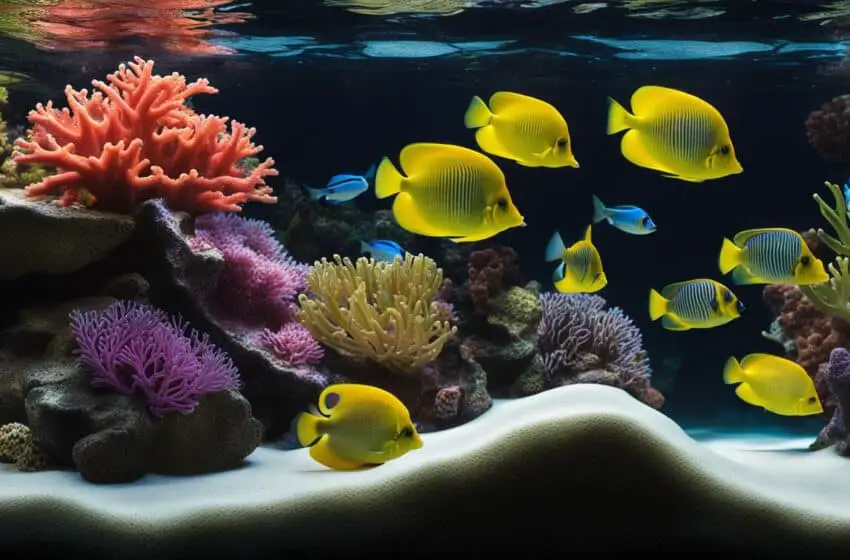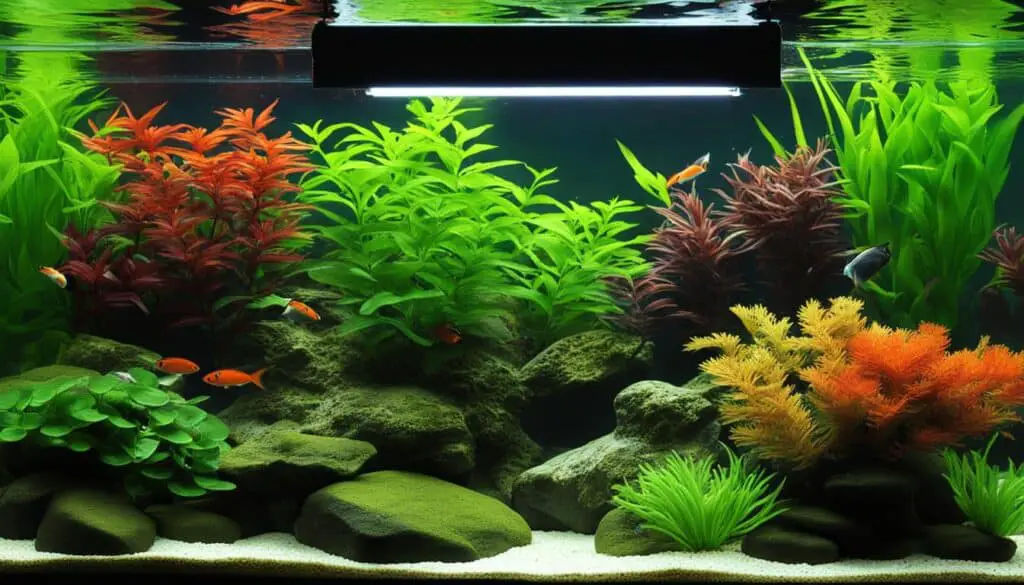Maximizing Energy Efficiency in Aquarium Lighting

A proficient lighting system can significantly influence temperature regulation, resulting in more stable and consistent conditions for your aquatic friends. LED lighting has revolutionized the aquarium industry, offering numerous advantages over traditional lighting options. LED lights are energy-efficient, long-lasting, customizable, and emit minimal heat. Natural sunlight also provides a complete range of light wavelengths necessary for the well-being and growth of aquatic plants. It promotes vibrant colors, enhances photosynthesis, and creates a more dynamic and natural environment. Both LED lighting and natural sunlight have their advantages and considerations, and the ideal choice depends on individual circumstances.
Key Takeaways:
- LED lighting is energy-efficient, long-lasting, and customizable.
- Natural sunlight provides a complete range of light wavelengths beneficial for aquatic plants.
- A proficient lighting system can influence temperature regulation in the aquarium.
- LED lighting emits minimal heat, reducing strain on aquarium thermostats.
- The choice between LED lighting and natural sunlight depends on individual circumstances.
The Importance of Lighting in Aquariums
Proper lighting plays a pivotal role in maintaining a thriving aquarium ecosystem. It enhances the aesthetics and visual appeal of the aquarium and provides essential energy for photosynthesis, helping aquatic plants and corals flourish. Lighting also influences the behavior, growth, and overall well-being of the aquarium’s inhabitants.
When it comes to aquarium lighting, there are various factors to consider. The intensity, spectrum, and duration of light exposure all play crucial roles in supporting the health and vitality of the aquatic life within.
A well-designed lighting system not only creates an appealing environment for you to enjoy but also mimics natural lighting conditions, allowing your aquarium inhabitants to thrive. By replicating the effects of sunlight, you can provide the necessary energy for photosynthesis, which is vital for the growth and overall well-being of aquatic plants and corals.
Lighting also impacts the behavior of aquarium inhabitants. Properly lit aquariums can stimulate natural behaviors and activity patterns, contributing to the overall vitality and health of the ecosystem.
“The right lighting can truly transform an aquarium into a mesmerizing underwater world, enhancing the natural colors and showcasing the intricate beauty of the marine inhabitants.” – Aquarium Expert
When selecting a lighting system for your aquarium, it’s vital to consider its impact on thermostat efficiency. Temperature regulation plays a crucial role in creating a stable and comfortable environment for your aquatic friends. A proficient lighting system can significantly influence temperature regulation, ensuring a consistent and optimal habitat for your aquarium inhabitants.
| Benefits of Proper Aquarium Lighting |
|---|
| Enhances photosynthesis and promotes lush plant growth |
| Stimulates natural behavior and activity patterns |
| Supports the overall well-being of aquarium inhabitants |
| Creates an aesthetically pleasing environment |
Investing in a high-quality lighting system tailored to the specific needs of your aquarium is essential for creating a vibrant and thriving ecosystem. It’s important to strike a balance between aesthetics and functionality, ensuring the overall well-being of your aquatic inhabitants.
LED Lighting: The Efficient and Versatile Choice
LED lighting has revolutionized the aquarium industry, offering numerous advantages over traditional lighting options. LED lights consume significantly less power while delivering higher light output, resulting in lower electricity bills and reduced environmental impact. They also have an impressive lifespan of up to 50,000 hours, ensuring consistent light output throughout their lifespan.
One of the key advantages of LED lighting is its unparalleled flexibility. Aquarists can customize the color spectrum and intensity of LED lights, allowing them to create mesmerizing lighting effects that mimic natural sunlight. This customization capability provides aquarists with the creative freedom to design their aquarium lighting to match their preferences and create a visually stunning underwater environment.
Another significant benefit of LED lighting is its minimal heat generation. Unlike traditional lighting options, LED lights emit minimal heat, which reduces strain on aquarium thermostats and supports the overall well-being of aquatic life. The minimal heat generated by LED lights also helps maintain stable temperature conditions within the aquarium, ensuring a comfortable and stress-free environment for marine organisms.
Furthermore, the longevity of LED lights contributes to their cost-effectiveness. LED lights can last up to 50,000 hours, significantly longer than other lighting options. This longevity not only reduces the frequency of replacements but also lowers maintenance costs over time. Additionally, the durability of LED lights makes them ideal for aquarium environments, as they can withstand the moisture and humidity commonly found in aquatic setups.
Overall, LED lighting is a highly efficient and versatile choice for aquariums. Its energy efficiency, longevity, customization options, and minimal heat generation make it an excellent investment for aquarists looking to enhance their underwater display while providing optimal lighting conditions for their marine inhabitants.

| Features | LED Lighting | Traditional Lighting |
|---|---|---|
| Energy Efficiency | High | Low |
| Longevity | Up to 50,000 hours | Varies, generally shorter lifespan |
| Customization | Highly customizable color spectrums and intensity | Limited customization options |
| Heat Generation | Minimal heat emission | Can generate significant heat |
| Maintenance | Low maintenance, reduces replacement costs | May require frequent replacements |
Natural Sunlight: The Ultimate Lighting Solution
While LED lighting offers remarkable advantages, nothing can truly replicate the beauty and benefits of natural sunlight. Natural sunlight provides a complete range of light wavelengths necessary for the well-being and growth of aquatic plant life. It promotes vibrant colors, enhances photosynthesis, and creates an overall more dynamic and natural environment.
Exposure to natural sunlight enables marine life to synthesize vitamin D, supporting their immune systems and overall health. Utilizing natural sunlight as a lighting source eliminates the need for energy-consuming artificial lighting systems, significantly reducing electricity bills and environmental impact. Natural sunlight also helps establish a stable diurnal rhythm for aquarium inhabitants, facilitating proper behavior, feeding patterns, and overall well-being.

Natural sunlight is a cost-effective and energy-efficient option for lighting your aquarium. It provides full spectrum lighting, encompassing all the wavelengths needed for optimal aquatic plant and animal growth. Harnessing the power of natural sunlight promotes a more sustainable and environmentally friendly approach to aquarium lighting.
To fully appreciate the benefits of natural sunlight, it’s important to understand its impact on aquatic life. The sun’s rays influence biological clocks, helping marine organisms regulate their daily activities and thrive in their natural habitat. By integrating natural sunlight into your aquarium, you enhance the well-being of your underwater ecosystem, promoting the growth and vitality of your aquatic plants and animals.
Key Benefits of Natural Sunlight in Aquariums:
- Enhances vibrant colors and promotes natural growth.
- Supports the synthesis of vitamin D for immune system health and vitality.
- Reduces energy consumption and electricity bills.
- Establishes a stable diurnal rhythm for proper behavior and feeding patterns.
- Promotes a more sustainable and eco-friendly approach to aquarium lighting.
When harnessing the power of natural sunlight in your aquarium, it’s important to strike a balance between direct exposure and adequate shade. Direct and prolonged exposure to intense sunlight can lead to excessive heat, algae growth, and potential harm to aquatic life. Consider implementing shading options or utilizing windows that filter harmful UV rays.
Conclusion
Optimizing the lighting system in your aquarium is crucial for creating a vibrant and captivating display while ensuring the well-being and growth of your marine inhabitants. Investing in energy-efficient LED lighting systems, such as LED strips, spotlight bulbs, light controllers, and moonlights, can enhance the aesthetics of your aquarium and offer numerous benefits.
LED lighting add-ons provide not only energy efficiency but also a wide range of customization options and lighting effects. These add-ons are long-lasting, low maintenance, and environmentally friendly, making them a sustainable choice for your aquarium. By choosing the right LED lighting system for your aquarium’s specific needs, you can create a visually stunning underwater world that shines brightly.
Whether you prefer the flexibility and versatility of LED lighting or the natural beauty of sunlight, optimizing your aquarium’s lighting will result in a vibrant and thriving aquatic display. Create a mesmerizing ambiance with LED lighting effects or harness the benefits of natural sunlight, promoting vibrant colors, enhanced photosynthesis, and the overall well-being of your aquatic ecosystem. Make your aquarium a true masterpiece, customized to showcase your unique style and provide an optimal habitat for your marine life.
FAQ
How does lighting impact the temperature regulation in an aquarium?
A proficient lighting system can significantly influence temperature regulation, resulting in more stable and consistent conditions for your aquatic friends.
What are the advantages of LED lighting in aquariums?
LED lighting has revolutionized the aquarium industry, offering numerous advantages over traditional lighting options. LED lights are energy-efficient, long-lasting, customizable, and emit minimal heat.
What are the benefits of natural sunlight in aquariums?
Natural sunlight provides a complete range of light wavelengths necessary for the well-being and growth of aquatic plants. It promotes vibrant colors, enhances photosynthesis, and creates a more dynamic and natural environment.
Which lighting option is more energy-efficient, LED lighting or natural sunlight?
Both LED lighting and natural sunlight have their advantages and considerations, and the ideal choice depends on individual circumstances. LED lighting offers energy efficiency, while natural sunlight eliminates the need for energy-consuming artificial lighting systems.
What are some factors to consider when choosing an aquarium lighting system?
When selecting a lighting system, it’s vital to consider its impact on thermostat efficiency, energy consumption, customization options, longevity, and overall impact on the aquarium ecosystem.



